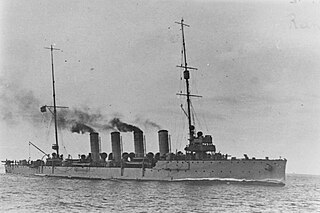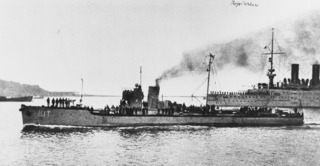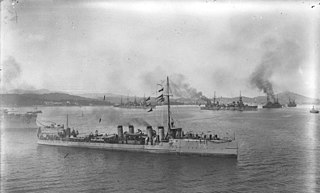
SMS Szent István was the last of four Tegetthoff-class dreadnought battleships built for the Austro-Hungarian Navy. Szent István was the only ship of her class to be built within the Hungarian part of the Austro-Hungarian Empire, a concession made to the Hungarian government in return for its support for the 1910 and 1911 naval budgets which funded the Tegetthoff class. She was built at the Ganz-Danubius shipyard in Fiume, where she was laid down in January 1912. She was launched two years later in 1914, but Szent István's construction was delayed due to the smaller shipyards in Fiume, and further delayed by the outbreak of World War I in July 1914. She was finally commissioned into the Austro-Hungarian Navy in December 1915.

The Adriatic Campaign of World War I was a naval campaign fought between the Central Powers and the Mediterranean squadrons of Great Britain, France, the Kingdom of Italy, Australia and the United States.

SMS Novara was a Novara-class scout cruiser of the Austro-Hungarian Navy which served during World War I. Built by the Danubius shipyard between December 1912 and January 1915, Novara was the third and final member of her class to enter service, some six months after the start of the war. She was armed with a battery of nine 10-centimeter (3.9 in) guns and had a top speed of 27 knots.
SM U-16 or U-XVI was a U-10-class submarine or U-boat of the Austro-Hungarian Navy during World War I. U-16 was constructed in Germany and shipped by rail to Pola where she was assembled and completed in September 1915. She was commissioned in October 1915.

SM U-17 or U-XVII was a U-10-class submarine or U-boat of the Austro-Hungarian Navy during World War I. U-17 was laid down in Germany in April 1915 and shipped in sections by rail to Pola in August, where she was assembled. She was delivered to the Austro-Hungarian Navy at the end of September and commissioned in October 1915.
SS Principe Umberto was an Italian passenger and refrigerated cargo ship built in 1908 for Navigazione Generale Italiana. During World War I, Principe Umberto served as an armed merchant cruiser.

The Second Battle of Durazzo, or the Bombardment of Durazzo was a naval battle fought in the Adriatic Sea during the First World War. A large allied fleet led by the Regia Marina attacked the enemy-held port at Durazzo, Albania. The fleet destroyed the Austro-Hungarian shore defenses and skirmished with a small naval force. Allied forces involved primarily were Italian though British, American and Australian warships also participated. It was the largest naval battle the United States participated in during the war. Most of the city was destroyed in the bombardment.

Cesare Rossarol was a scout cruiser built in Sestri Ponente, Genoa, in 1913 and launched by S.A.I. Gio. Ansaldo & C. in Liguria, Italy, in 1914. Like her sister ships, Alessandro Poerio and Guglielmo Pepe, she was named after a famous Neapolitan light cavalryman who helped defend Venice from attacks by the Austro-Hungarian Army during the revolutions in 1848.

T1 was a seagoing torpedo boat that was operated by the Royal Yugoslav Navy between 1921 and 1941. Originally 76 T, a 250t-class torpedo boat of the Austro-Hungarian Navy built in 1914, she was armed with two 66 mm (2.6 in) guns and four 450 mm (17.7 in) torpedo tubes, and could carry 10–12 naval mines. She saw active service during World War I, performing convoy, escort and minesweeping tasks, anti-submarine operations and shore bombardment missions. She was part of the escort force for the Austro-Hungarian dreadnought SMS Szent István during the action that resulted in the sinking of that ship by Italian torpedo boats in June 1918. Following Austria-Hungary's defeat later that year, 76 T was allocated to the Navy of the Kingdom of Serbs, Croats and Slovenes, which became the Royal Yugoslav Navy, and was renamed T1. At the time, she and seven other 250t-class boats were the only modern sea-going vessels of the fledgling maritime force.

SS Linz was an Austro-Hungarian Ocean Liner that hit a mine in the Adriatic Sea 4 miles northwest of the Cape of Rodon, while she was travelling from Fiume, Croatia to Durazzo, Albania under command of Captain Tonello Hugo.

Dague was one of a dozen Bouclier-class destroyers built for the French Navy in the first decade of the 20th century. Completed in 1912, the ship was initially assigned to the 1st Naval Army in the Mediterranean Sea. During the First World War, she escorted the battle fleet during the Battle of Antivari off the coast of Montenegro in August 1914 and escorted multiple convoys to Montenegro over the next six months. Dague struck a mine in Antivari harbor in February 1915 and sank with the loss of 38 crewmen.

Faulx was one of a dozen Bouclier-class destroyers built for the French Navy in the first decade of the 20th century. During the First World War, she escorted the battle fleet during the Battle of Antivari off the coast of Montenegro in August 1914 and escorted multiple convoys to Montenegro for the rest of the year. Faulx protected the evacuation of the Royal Serbian Army from Durazzo, Albania, in February 1916.

Fourche was one of a dozen Bouclier-class destroyers built for the French Navy in the first decade of the 20th century. During the First World War, she escorted the battle fleet during the Battle of Antivari off the coast of Montenegro in August 1914 and escorted multiple convoys to Montenegro for the rest of the year. Fourche protected the evacuation of the Royal Serbian Army from Durazzo, Albania, in February 1916. The ship was sunk by an Austro-Hungarian submarine in June with the loss of 19 crewmen.

Renaudin was one of six Bisson-class destroyers built for the French Navy during the early 1910s. Completed in 1913, the ship was assigned to the 1st Naval Army in the Mediterranean Sea. During the First World War, she escorted the battle fleet during the Battle of Antivari in August 1914 and escorted multiple convoys to Montenegro for the rest of the year. Renaudin helped to sink a crippled Austro-Hungarian destroyer during the 1st Battle of Durazzo in late 1915 and protected the evacuation of the Royal Serbian Army from Durazzo, Albania, in February 1916. The ship was sunk by an Austro-Hungarian submarine the following month with the loss of 50 crewmen.

Bisson was the name ship of her class of destroyers built for the French Navy during the 1910s, entering service in 1913. She served in the Mediterranean Sea during the First World War, sinking the Austro-Hungarian submarine U-3 on 6 July 1915 and took part in the Battle of Durazzo in December 1915 and the Battle of the Strait of Otranto in May 1917. She was stricken in 1933 and scrapped in 1939.

The Yugoslav torpedo boat T5 was a sea-going torpedo boat operated by the Royal Yugoslav Navy between 1921 and 1941. Originally 87 F, a 250t-class torpedo boat of the Austro-Hungarian Navy built in 1914–1915, she was armed with two 66 mm (2.6 in) guns and four 450 mm (17.7 in) torpedo tubes, and could carry 10–12 naval mines. She saw active service during World War I, performing convoy, patrol, escort and minesweeping tasks, anti-submarine operations and shore bombardment missions. Following Austria-Hungary's defeat in 1918, 87 F was allocated to the Navy of the Kingdom of Serbs, Croats and Slovenes, which became the Royal Yugoslav Navy, and was renamed T5. At the time, she and the seven other 250t-class boats were the only modern sea-going vessels of the fledgling maritime force.

NMS Mărășești was one of four Vifor-class destroyers ordered by Romania shortly before the beginning of the First World War from Italy. All four sister ships were requisitioned when Italy joined the war in 1915. Originally named Vârtej by the Romanians, she was renamed Nibbio in Italian service. Not completed until mid-1918, the ship engaged Austro-Hungarian ships in the Adriatic Sea only once before the war ended in November. She was renamed Mărășești when she was re-purchased by the Romanians in 1920.

SMS Admiral Spaun was a scout cruiser built for the Austro-Hungarian Navy. Named for Admiral and Marinekommandant Hermann von Spaun, Admiral Spaun was constructed shortly before World War I. Laid down at the Pola Navy Yard in May 1908, the cruiser was launched in October 1909. Admiral Spaun was commissioned into the Navy just over a year later, in November 1910. The first ship of the Austro-Hungarian Navy to be constructed with steam turbines, her design later influenced the construction of the Novara-class cruisers.

SMS Csepel was one of six Tátra-class destroyers built for the kaiserliche und königliche Kriegsmarine shortly before the First World War. Completed in 1913, she helped to sink an Italian destroyer during the action off Vieste in May 1915 after Italy declared war on Austria-Hungary. Two months later the ship participated in an unsuccessful attempt to recapture a small island in the central Adriatic Sea from the Italians. In November and early December Csepel was one of the ships conducting raids off the Albanian coast to interdict the supply lines between Italy and Albania. She was hit one time during the First Battle of Durazzo in late December. Her stern was blown off by a French submarine in early 1916 and her repairs were not completed until early 1917.

SMS Tátra was the lead ship of her class of six destroyers built for the kaiserliche und königliche Kriegsmarine shortly before the First World War. Completed in 1913, she helped to sink an Italian destroyer during the action off Vieste in May 1915 after Italy declared war on Austria-Hungary. Two months later the ship participated in an unsuccessful attempt to recapture a small island in the Central Adriatic Sea from the Italians. In November and early December Tátra was one of the ships conducting raids off the Albanian coast to interdict the supply lines between Italy and Albania. During the early stages of the 1st Battle of Durazzo in late December, the ship was tasked to tow her one of her sister ships that had been crippled by a mine. She was forced to abandon her sister when the Austro-Hungarians were spotted by a strong force of Allied ships and had to evade their pursuit. Tátra participated in several unsuccessful raids on the Otranto Barrage in 1917. She was transferred to Italy in 1920 in accordance with the peace treaties ending the war and renamed Fasana. The Regia Marina used her for spare parts; she was discarded in 1923 and subsequently scrapped.

















